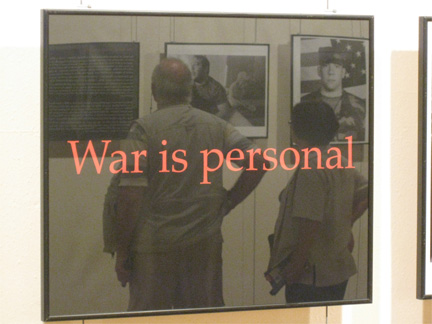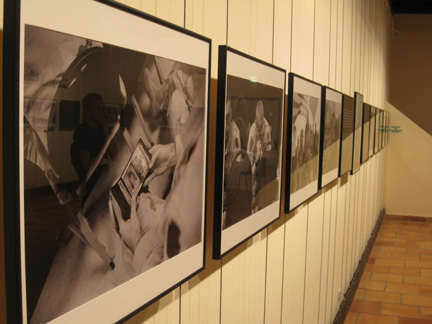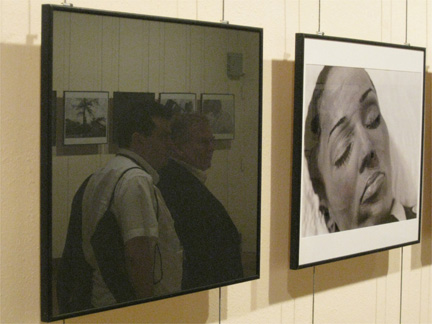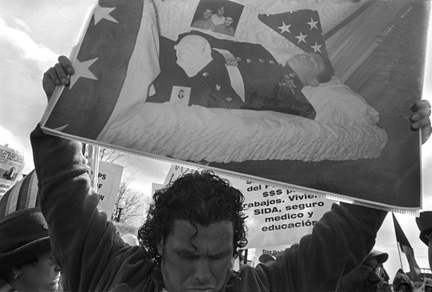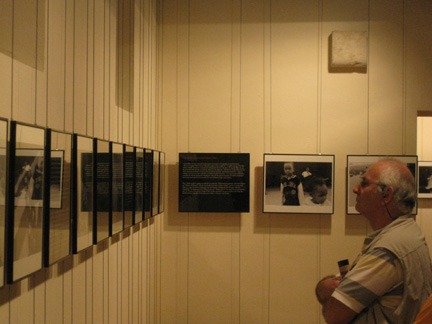Perpignan photojournalism festival
Broken bodies of the US's Iraq veterans
by Aidan O'Donnell
Article published on the 2009-09-04 Latest update 2009-09-07 14:45 TU
I tracked down Eugene Richards in Perpignan’s Minimes convent, where his War is personal is showing. It is probably one of the most powerful exhibitions at Visa pour l’image.
His collection portrays a series of US military veterans, after their return from Iraq.
Although much of it is understated, and despite the breathing space given to the subjects, it fairly takes the visitor apart nonetheless. A father grieving for his son, the funeral of a young black female sergeant, a deserter who has fled with her young family to Canada or a family reluctantly waiting for a young man to go back out.
Then there are the broken bodies of the wounded. Tomas Young, a 26-year-old, was shot on his fourth day in Iraq and is now paralysed from the waist down.
“The first person I contacted was Tomas,” says Richards. “He, in some ways, is the inspiration for the project.
“I went out to see him - he lived in Kansas City. I interviewed him as best I could and then I called him up afterwards,” Richards recounts, explaining that he was initially uneasy with putting out these pictures of people who’d been damaged, either physically or emotionally. “I didn’t want the pictures to be sensational”.
Today he smiles, remembering his phone call to Tomas. “I called him up and, to put it bluntly, [said to him] ‘you look like shit in my pictures, you look terrible'”.
“‘They’re true, right? The pictures?’” the veteran asked Richards rhetorically. Young didn’t see any problem.
“And that was it. And I then started going off to do the next story and the next story and I never looked back, the way I did with Tomas,” says Richards who travelled the US interviewing and photographing those affected by the war.
The pictures look like he spent days, if not weeks or months, establishing the relationship with these people that would allow him to photograph them in hospital, in coffins or in tears. But he says it was the opposite.
“I thought I would do the stories in a more spontaneous manner, the way I did with Tomas. I would go in, the interview would be then, not over a period of days. The pictures would most likely be then and they would stand for what they were”.
“So they’re not the whole life of a person”, he says. “As a result, because of the urgency, people told me a lot more."
He agrees that it is a profoundly political exhibition. You come away aware that it is an anti-war exhibition from an anti-war photographer. But Richards says the work was more complicated and that he was careful not to get carried away by his emotions.
“You have to control your feelings, you have to put them behind you,” he says, “I was trying to control myself and make sure I saw everybody.”
“It is political, and I did want it to be,” he says. “But I’m not naïve, a little book with photographs is not a big thing. I mean if you do a book it’s 3,000 copies, small magazine runs, but you do want it to be discussed and that’s political.”
The impulse to begin the photographic essays came from wanting to do something beyond just saying that he was opposed to the war in Iraq.
“It’s too simple to say ‘I’m against the war’, like holding a placard against the war".
“It involves why people go in the military - it’s a volunteer military. I’ve heard a lot of people say ‘That man’s got a hole in his head? Well that was his choice’."
“People say that,” he notes.
Richards says the anti-war tag is too simplistic, referring to “Dusty, the man with all the burns on his face”. Dusty Hill lost both hands, most of his right ear and suffered burns to a third of his body in Baghdad in 2004.
In the exhibition’s photos he’s playing with his daughter, and in a short text he explains that he’s a lucky man to be able to play with his baby daughter all day, while others barely see their kids because they’re working all day.
Dusty, says Richards, is now a military recruiter.
“And why? Dusty’s a very attractive man. You realise that you find him amazing, so a 17, 18-year-old guy goes ‘well Dusty’s lost his hands, he’s lost his face and he still would do it again. Well maybe I’m brave like that’."
“It’s a frightening thought,” says Richards, recounting cases of parents bringing their children to meet Dusty with a view to dissuading them from joining the marines.
"It worked just the opposite, they joined because of meeting Dusty. So it’s complicated, it’s not simple,” he says.
Dusty’s words hang framed on the wall beside his pictures and other texts appear throughout the exhibition. Richards is increasingly impressed with the attention these hanging paragraphs receive from visitors, something he noticed with an earlier exhibition on 9/11. “We ran pieces of text with the photographs and I actually saw people going along, all stooped over, reading the text, it surprised me.”
“This exhibition has been enlightening for me because I walked around with people and I was amazed that they read the text. Everybody read the text,” he says. “Increasingly, and even here, our images are more and more decontextualised, most photographers don’t even know the names of their subjects."
War is personal does not make for light viewing. Richards says that he gets tired of being told that it’s “depressing”, as if no space can be made for these people’s stories. It is partly intended to be dark.
“The reality of the suffering that these people went through is far, far more critical than I showed,” he says. His exhibition shows “the aftermath”.




